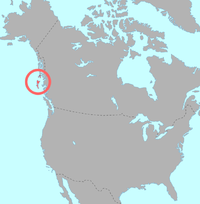X̲aat 語(ANLC系統:X̲aat Kíl, X̲aadas Kíl, X̲aayda Kil)是 X̲aat 人的語言。該語言有8個元音和超過30個輔音。語言學家Edward Sapir曾在1915年把 X̲aat 語歸為納-德內語系,該提議隨即受到諸多語言學家(如Pinnow, Greenberg, Enrico, Ruhlen, Manaster Ramer, and Bengtson,詳見參考文獻列表)的支持;然而,今天大多數語言學家將 X̲aat 語看作是一個孤立語言。[1]08年語言學界提議美洲的納-德內語系和北亞(中西伯利亞)的葉尼塞語系同源並構成德內-葉尼塞語門,[2]卻沒有任何跡象表明 X̲aat 語屬於該語門。
大約100年前,全體 X̲aat 人都使用 X̲aat 語,[3]但今天 X̲aat 語卻是extremely endangered, with only about 40 native speakers,[4] nearly all of whom are older adults.[5][6] Although the number of native speakers has diminished along the years, according to a 2001 Canadian Census there are now about 275 speakers in British Columbia alone,[3] and with revived interest in the language, this figure is expected to grow.
Currently Haida citizens and friends in all three dialect communities are working to revitalizing the language. In Skidegate, fluent speakers gather on a daily basis to work on the southern or Skidegate dialect and have produced a large series of recordings. In Masset, a group of younger learners is working with their fluent elders to reintegrate the northern or Masset dialect into their daily lives. In Alaska, the community conducts regular language classes for teens and adults, and has built a website complete with online recordings of the Kaigani dialect.
History
The Rev. John Henry Keen, a missionary, translated the Book of Common Prayer into Haida. Keen returned to England on leave in 1898 and his translated prayer book was published in 1899 in London by the Missionary Society.[7] Sadly the book went out of print as the people it was intended to be read by, were dying out. It is estimated that before the Europeans arrived there were 10,000 people who spoke Haida. By 1900 there were about 700.[8] Keen was to go on to translate the gospels of Luke and John and the Acts from the New Testament into Haida.[9]
Sounds
(參見書寫系統一節)按北部方言Kaigani土語ANLC系統、北部方言Masset土語恩里科系統、南部方言Skidegate土語恩里科系統、IPA給出:
| Bilabiales | Alvéolaires | Palatales | Vélaires | Uvulaires | Pharyngales | Glottales | |||
|---|---|---|---|---|---|---|---|---|---|
| centrales | latérales | ||||||||
| Occlusives | pleines | b b b [b̥] | d d d [d̥] | g g g [g̊] | ĝ G r [ɢ̥] | ||||
| aspirées | p p p [pʰ] | t t t [tʰ] | k k k [kʰ] | ḵ q q [qʰ] | |||||
| éjectives | p' p' p' [p̕] | t' t' t' [t̕] | k' k' k' [k̕] | ḵ' q' q' [q̕] | ' 7 7 [ʔ] | ||||
| Affriquées | voisées | dl dl dl [d̥͡ɫ] | j j j [d̥͡ʒ̊] | ||||||
| sourdes | ts ts ts [t͡s] | tl tl tl [t͡ɬʰ] | ch ts ts [t͡ʃ] | g̱ r – [ʔˤ] | |||||
| éjectives | ts' ts' ts' [t͡s̕] | tl' tl' tl' [t͡ɬ̕] | |||||||
| Fricatives | sourdes | s s s [s] | hl hl hl [ɬ] | x c c [ç] | x̂ X x [χ] | x̱ x – [ħ] | h h h [h] | ||
| Nasales | pleines | m m m [m] | n n n [n] | ng ng ng [ŋ] | |||||
| glottales | 'm 'm 'm [ˀm] | 'n 'n 'n [ˀn] | |||||||
| Spirantes | pleines | w w w [w] | l l l [ɫ] | y y y [j] | |||||
| glottales | 'w 'w 'w [ˀw] | 'l 'l 'l [ˀl] | 'y 'y 'y [ˀj] | ||||||
| Bilabial | Alveolar | Postalveolar / Palatal |
Velar | Uvular | Epi- glottal |
Glottal | |||
|---|---|---|---|---|---|---|---|---|---|
| central | lateral | ||||||||
| Plosive | plain | b̥ | d̥ | ɡ̊ | ɢ̥ | ʔ | |||
| aspirated | pʰ | tʰ | kʰ | qʰ | |||||
| ejective | pʼ | tʼ | kʼ | qʼ | |||||
| Contour Segment | lenis | d̥͡l | d̥͡ʒ̊ | ||||||
| fortis | t͡s | t͡ɬʰ | t͡ʃ | ʡ͡ʜ | |||||
| ejective | t͡sʼ | t͡ɬʼ | t͡ʃʼ | ||||||
| Fricative | voiceless | s | ɬ | x | χ | ʜ | h | ||
| Nasal | plain | m | n | ŋ | |||||
| glottalized | mˀ | nˀ | |||||||
| Approximant | plain | ɫ | j | w | |||||
| glottalized | lˀ | ||||||||
- ^1 Inside words, the plain stops can be voiced.
- ^2 For some speakers, [t͡ʃ] occurs only at the beginning of syllables, while [t͡s] does not occur there. They are the same phoneme. A similar situation applies with [t͡sʼ] and [t͡ʃʼ].[來源請求]
- ^3 Instead of an epiglottal fricative, the Masset dialect uses an epiglottal trill.
Haida features phonemic tone, the nature of which differs by dialect. In Kaigani the system is one of pitch accent, with at most one syllable per word featuring high tone; in Masset and Skidegate tone is contrastive in heavy syllables. All the above systems feature two tones: high and low.
書寫系統
X̲aat 語有兩套基於拉丁字母的書寫系統:在加拿大常用的,約翰·恩里科(John Enrico)提出的恩里科系統,用來書寫南 X̲aat 語;在美國常用的,阿拉斯加土著語言中心(Alaska Native Language Center)提出的ANLC系統,用來書寫北 X̲aat 語。
- ANLC系統區分兩個同位異音[t͡ʃ](英語的ch)和[t͡s](漢語拼音的c)。
- 恩里科系統是一種跨方言文字(儘管只跨了兩個加拿大方言),它在不同方言中給了不同的語音影射,使得在兩種方言中發音相同的詞有著不同的寫法,而寫法相同的詞有著不同的發音。[10]
X̲aat 語的兩套書寫系統部分與漢語拼音類似:字母B、D、G表示不吐氣的清音,而非濁音。
References
Publications describing Haida language structure or classification
External links
Wikiwand in your browser!
Seamless Wikipedia browsing. On steroids.
Every time you click a link to Wikipedia, Wiktionary or Wikiquote in your browser's search results, it will show the modern Wikiwand interface.
Wikiwand extension is a five stars, simple, with minimum permission required to keep your browsing private, safe and transparent.
